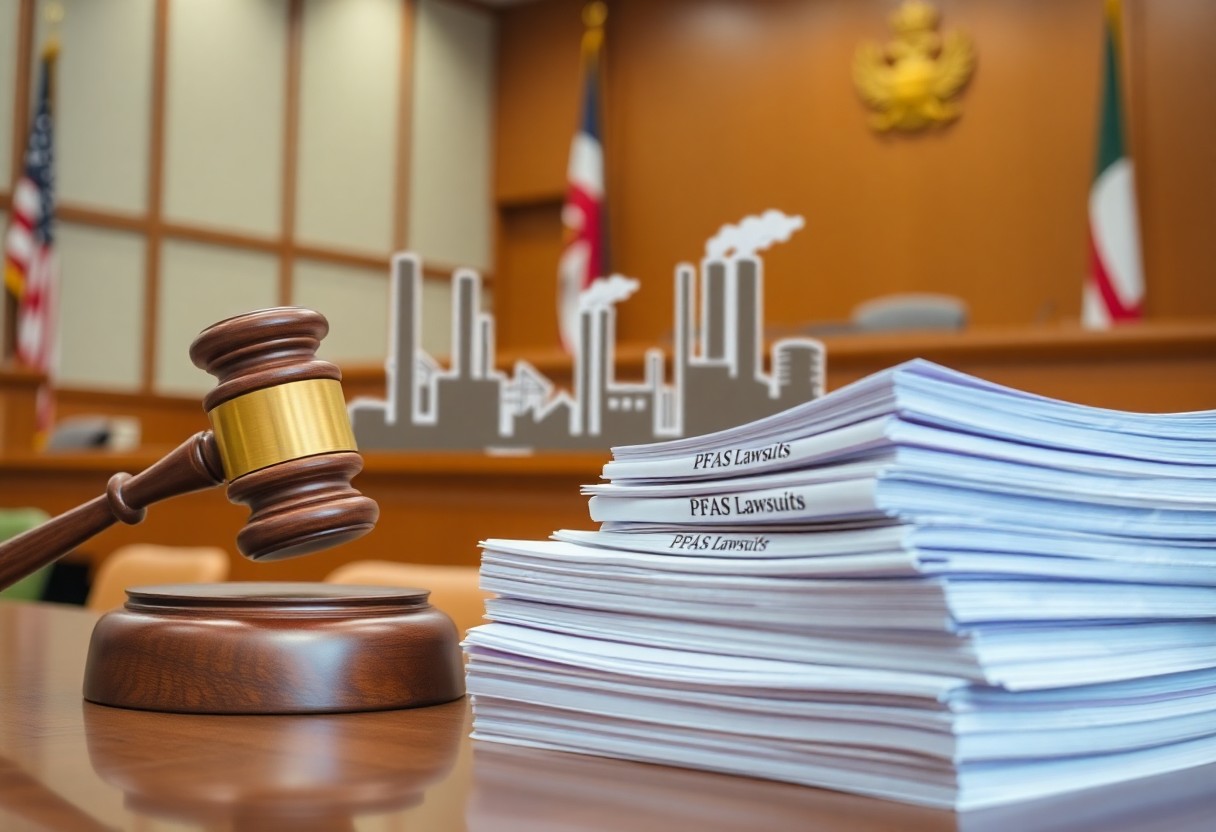You may be unaware that PFAS contamination poses a significant threat to the health and ecosystems of tribal lands across the United States. These per- and polyfluoroalkyl substances, often found in everyday products, have been linked to serious health issues and environmental degradation. As tribes continue to assert their rights and seek justice, several lawsuits have emerged, shining a light on the need for accountability from manufacturers and protectors of these sacred lands. Understanding these legal battles is crucial for promoting environmental justice and safeguarding the future of indigenous communities.
Understanding PFAS Contamination
For many, PFAS contamination may sound like a modern issue, but these substances have been present in various environments for decades. PFAS, or per- and polyfluoroalkyl substances, are synthetic chemicals resistant to water, heat, and oil, leading to widespread use in numerous products. Unfortunately, their persistence in the environment raises concerns about potential health impacts and contamination on tribal lands.
What are PFAS?
Behind the term PFAS lies a group of more than 4,500 man-made chemicals that have been linked to various health issues. You may find these substances in your everyday items, including non-stick cookware, water-repellent clothing, and food packaging. Their durable nature prevented the intended breakdown, allowing them to accumulate in the environment and within human bodies over time.
Sources of PFAS Contamination
Before understanding the repercussions of PFAS, it’s important to identify the sources of contamination. You could be exposed through drinking water, soil, and air, often originating from industrial sites, firefighting foam, and waste disposal. These sources can significantly affect tribal lands, highlighting the need for urgent action.
Another key aspect of PFAS contamination arises from various industrial processes, including production and disposal of PFAS-containing products. You should also be aware that firefighting foams used in training exercises or emergencies can introduce PFAS into the environment. Additionally, contaminated landfills and agricultural practices using biosolids can lead to widespread dispersal, making it critical to monitor your surroundings and advocate for cleaner practices to protect your health and community.
Impact of PFAS on Tribal Lands
Even as you explore the challenges faced by tribal lands, it becomes evident that PFAS contamination presents serious health risks to Native communities. These substances, often found in firefighting foams and industrial discharges, can seep into water systems, adversely affecting the environment and the people who rely on these resources. The contamination not only threatens traditional ways of life but also complicates the fight for justice and recognition of tribal rights.
Health Effects on Native Communities
On tribal lands, exposure to PFAS has been linked to a range of health issues, including increased risks of cancer, liver damage, and thyroid disease. As you consider the implications, it’s important to understand how these health effects compound existing disparities in healthcare access and outcome within Native communities.
Environmental Consequences
Between the disruption of natural ecosystems and the contamination of water sources, PFAS poses significant environmental threats on tribal lands. These substances can persist in the environment, accumulating in the soil, plants, and wildlife, which ultimately endangers traditional food sources that communities depend on.
This ongoing contamination has severe ramifications for the ecosystem, diminishing biodiversity and altering habitats. The presence of PFAS compromises water quality, making it unsafe for drinking and fishing—imperative components of many Native cultures. Furthermore, as you think about environmental stewardship, you’ll see that clean-up efforts and regulations often fall short, leaving indigenous communities to bear the burdens of industrial negligence while advocating for their fundamental rights to protect their land and health.
Legal Framework for PFAS Lawsuits
Now, understanding the legal framework for PFAS lawsuits is crucial as it shapes how cases are brought forth and adjudicated. Lawsuits related to per- and polyfluoroalkyl substances (PFAS) often hinge on a complex matrix of federal, state, and tribal laws that govern environmental contamination and health risks.
Overview of Environmental Law
Environmental law serves as a foundation for PFAS lawsuits, providing the regulations and statutes that address pollution and the protection of public health. These laws encompass both federal acts, like the Clean Water Act, and various state regulations that guide how industries manage hazardous substances.
Tribal Sovereignty and Legal Challenges
An understanding of tribal sovereignty is vital when navigating PFAS contamination issues, as it affects the legal avenues available to tribal nations. Tribal sovereignty allows tribes to govern themselves and manage their lands, but this can create legal challenges when seeking justice against polluters.
Lawsuits involving PFAS contamination on tribal lands can be complicated by issues of sovereignty, as tribes may pursue cases in federal or state courts that may not recognize their authority fully. You face potential hurdles in proving jurisdiction and asserting rights to your lands, as numerous legal precedents may limit the extent to which a tribe can sue. Nonetheless, some tribes have successfully argued their position, emphasizing a need for protection from dangerous PFAS exposure and seeking accountability from manufacturers. Understanding these dynamics is key to navigating your legal options effectively.
Case Studies of Tribal PFAS Lawsuits
Keep in mind the varying impacts of PFAS contamination on tribal lands as you explore these significant case studies:
- 1. The Cheyenne River Sioux Tribe against military contractors, resulting in a proposed $25 million settlement for contaminated water supplies.
- 2. The La Jolla Band of Luiseño Indians pursuing legal action against a chemical manufacturer for contamination affecting fisheries and agriculture.
- 3. A landmark case involving the Catawba Indian Nation, which led to state officials agreeing to monitor PFAS levels near tribal lands.
- 4. The Oglala Sioux Tribe lawsuit against a local government for health impacts linked to PFAS, resulting in ongoing negotiations for health compensation.
Notable Lawsuits and Outcomes
By examining various tribal lawsuits, you’ll uncover significant outcomes, such as increased awareness about PFAS dangers, legislative changes promoting testing, and improved funding for contaminated site remediation, shaping future legal strategies.
Lessons Learned
On critically analyzing these cases, you’ll find that effective legal strategies often hinge on strong community awareness and collaboration between tribes and environmental advocates, emphasizing the importance of education, scientific research, and legal preparedness.
Lawsuits can serve as powerful tools for justice and environmental restoration. Your key takeaways include prioritizing outreach within tribal communities to facilitate knowledge sharing on PFAS health effects and fostering alliances with environmental organizations. Addressing water safety and advocating for legislative reforms are paramount. Should your tribe confront similar challenges, leveraging community voices can enhance potential legal success and drive meaningful change toward safer environments.

Strategies for Advocacy and Resolution
After identifying the impact of PFAS contamination on your community, it’s necessary to develop strategies for advocacy and resolution. Engaging with tribal leadership and community members will foster a unified front, ensuring that your voice carries weight in local and state discussions. Focus on building strong partnerships with environmental organizations and leveraging public awareness to push for effective policy changes. Initiating dialogue with responsible parties and regulatory bodies can also lead to tangible results and improved outcomes for your community.
Community Engagement and Education
Below, fostering community engagement and education is vital in addressing PFAS contamination. You should organize forums, workshops, and outreach programs to provide your community with pertinent information about the risks associated with PFAS exposure. By empowering your community through knowledge, you can build a coalition of advocates committed to pursuing justice and advocating for effective remediation efforts.
Collaborating with Legal Experts
An integral part of your advocacy strategy will be collaborating with legal experts who specialize in environmental law and PFAS litigation. These professionals can guide you through the complex legal landscape, advising on the best approach to take for your community’s unique situation.
To ensure you navigate the legal framework effectively, seek out legal experts with proven experience dealing with PFAS contamination lawsuits. This collaboration enables you to tailor your approach to the specific needs of your community and maximize your chances of success. A knowledgeable attorney can help you gather necessary evidence, understand potential compensation avenues, and guide you through settlement negotiations or court proceedings. With the right legal team, you can significantly enhance your community’s ability to seek justice and establish accountability for contaminators, ultimately working towards a safer environment.
Future Directions in PFAS Litigation
Not only are you witnessing a surge in PFAS litigation, but the legal landscape is also evolving as new evidence and scientific findings emerge. Courts are beginning to recognize the complexities of PFAS contamination and its long-term effects on public health and the environment. As awareness grows, you can expect more comprehensive legal frameworks and potential precedents that may reshape how individuals and communities engage in PFAS-related lawsuits.
Emerging Trends in Lawsuits
To understand the current landscape of PFAS litigation, you should be aware of emerging trends such as class-action lawsuits and increased collaborations between affected communities and environmental advocacy groups. These trends highlight the collective impact of PFAS contamination, amplifying legal pressure on manufacturers and prompting discussions about accountability and responsibility.
Policy Recommendations
PFAS regulations are vital in addressing the severe risks posed by these chemicals. You should support policies that mandate strict emissions limits and ensure proper disposal practices to mitigate further contamination. Moreover, transparency in chemical disclosures is vital for empowering communities affected by PFAS pollution to advocate for their rights effectively.
Due to the alarming persistence of PFAS in the environment and its associated health risks, strong policy recommendations are required for effective management and remediation. You need to advocate for enhanced regulatory frameworks that prioritize public health and environmental protection. This includes supporting initiatives for removal of PFAS from drinking water sources, stricter testing and monitoring of industrial discharges, and funding for research on PFAS alternatives. By engaging in policy advocacy, you help shape a future that prioritizes the safety of your community and the environment.
Conclusion
Hence, your awareness of the intersection between tribal lands and PFAS contamination lawsuits is vital. Understanding the legal and environmental implications allows you to appreciate the challenges faced by indigenous communities and their fight for justice. Staying informed can empower you to support efforts that advocate for the protection of these lands and the health of those who inhabit them. Engaging in discussions and actions surrounding this issue can contribute to meaningful change and recognition of the rights of tribal nations.



















